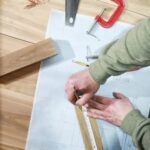What is best to fill bark seams in woodwork? When it comes to achieving a seamless and professional finish in woodworking projects, filling bark seams is a crucial step.
Bark seams are natural indentations or gaps in wood caused by the removal of bark, and if left unfilled, they can detract from the overall appearance of the finished piece. In this article, we will explore the issue of bark seams in woodwork and discuss the importance of selecting the best filler to achieve a smooth and professional finish.
Bark seams are a common occurrence in woodwork, especially when working with live edge or reclaimed wood. These seams occur when the bark is removed from the surface of the wood, leaving behind irregular edges and gaps that need to be filled for a polished look. If left untreated, bark seams can collect dirt and debris, leading to potential structural issues over time. Additionally, unfilled bark seams can disrupt the overall aesthetic appeal of a woodworking project.
Properly filling bark seams is crucial for both aesthetic and functional reasons in woodworking. Not only does it enhance the appearance of the finished piece, but it also ensures that the surface remains smooth and even.
It is essential to select the right filler for filling bark seams to achieve a flawless result. In the following sections, we will delve into different types of fillers available and provide tips for achieving a professional finish when working with bark seams in woodwork.
Understanding Bark Seams
Bark seams are a natural occurrence in woodwork where the wood’s original bark is still attached to the material. This happens when live-edge slabs of wood are used, and the bark from the tree is incorporated into the design of the furniture or other woodworking project.
While this can create a unique and visually appealing look, it also presents some challenges that need to be addressed, especially when it comes to filling in these bark seams for a professional finish.
What Are Bark Seams?
Bark seams occur when the natural bark of a tree is still present on the edges of wooden slabs or boards. These seams create gaps between the wood and the bark, which need to be filled to achieve a seamless look. Understanding how and why these bark seams form is crucial for properly addressing them during the woodworking process.
Potential Problems Caused by Unfilled Bark Seams
If left unfilled, bark seams in woodwork can lead to several issues. First, they can compromise the structural integrity of the piece, causing potential weakness or instability. Additionally, unfilled bark seams can collect dust and debris over time, making cleaning and maintenance more difficult. From an aesthetic standpoint, unfilled gaps can detract from the overall appearance of the finished piece, taking away from its visual appeal.
As such, understanding how these gaps form and knowing their potential consequences underscores the importance of finding suitable fillers for addressing bark seams in woodwork.
Importance of Filling Bark Seams
Bark seams in woodwork can occur when the natural bark of a tree separates from the wood, leaving behind gaps or seams that need to be filled. Filling these bark seams is crucial for both aesthetic and functional reasons.
From a visual standpoint, unfilled bark seams can disrupt the overall appearance of the woodwork, making it look unprofessional and unfinished. Functionally, unfilled bark seams can also cause issues such as trapping dirt and moisture, leading to potential decay or damage to the wood over time.
One of the major reasons why filling bark seams in woodwork is essential is for the structural integrity of the project. When left open, these crevices can collect dust, debris, and even insects which can lead to rot and damage if not addressed promptly. Additionally, filling these crevices can prevent potential snags on clothing or injuries caused by splinters or sharp edges sticking out.
In terms of aesthetics, filling bark seams ensures a seamless and polished finish, creating a more professional look overall. Whether it’s furniture, cabinets, or any other woodworking project, properly filled bark seams contribute to an overall cohesive and refined appearance.
Ultimately, taking the time to fill these gaps will lead to a longer-lasting and visually appealing result. Through proper sealing techniques and filler selection during this stage of woodworking projects against nature’s control over untreated wood surfaces will come out better protected both aesthetically and functionally.
| Reasons for Filling Bark Seams | Effect |
|---|---|
| Structural Integrity | Prevents potential rot or damage |
| Aesthetics | Ensures a seamless and polished finish |
| Functionality | Prevents potential injuries caused by splinters or sharp edges sticking out |
Types of Fillers
When it comes to filling bark seams in woodwork, selecting the right type of filler is crucial for achieving a smooth and professional finish. There are several options available, each with its own set of advantages and disadvantages. Here are the main types of fillers to consider:
- Wood Fillers: These fillers are specifically designed to match the natural color and grain of wood, making them a popular choice for filling bark seams. They come in various formulations, including water-based and solvent-based options.
- Epoxy Fillers: Epoxy fillers offer exceptional durability and resistance to moisture, making them ideal for outdoor applications or areas prone to high levels of humidity. They can also be tinted to match the color of the wood.
- Putty Fillers: Putty fillers are often used for smaller imperfections and cracks, including bark seams. They are easy to work with and can be sanded and stained to blend seamlessly with the surrounding wood.
Each type of filler has its own unique characteristics, so it’s important to consider the specific requirements of your woodwork project before making a decision on which filler to use.
It’s worth noting that some fillers may require mixing or special application techniques, so be sure to carefully read the manufacturer’s instructions before using them. Additionally, considering factors such as drying time, sandability, and compatibility with stains or finishes can help you determine which filler will be best suited for your needs when filling bark seams in woodwork.
Application Techniques
Preparing the Surface
Before applying any filler to bark seams in woodwork, it is crucial to properly prepare the surface. This involves cleaning the area thoroughly to remove any dirt, dust, or debris that may affect the adhesion of the filler. Additionally, it is important to ensure that the bark seam is dry and free of moisture to prevent any potential issues with the filler’s performance.
Choosing the Right Filler
When selecting a filler for bark seams in woodwork, it is essential to choose a product that is specifically designed for use in woodworking applications. Wood fillers, epoxy fillers, and putty fillers are all viable options and each has its own advantages and disadvantages. Consider factors such as the color match, drying time, hardness when cured, and ease of application when choosing the best filler for your project.
Applying the Filler
Once you have selected the appropriate filler for your bark seams, follow the manufacturer’s instructions for application carefully. Using a putty knife or similar tool, apply the filler generously into the bark seam, ensuring that it fills the entire void completely. It is important to overfill the seam slightly to account for shrinkage as some fillers dry or cure.
After applying the filler, use a clean putty knife to scrape away any excess material from the surface of the wood. For a smooth and seamless finish, take care to blend and feather out the edges of the filler so that it seamlessly integrates with surrounding wood surfaces. After allowing sufficient time for drying or curing as per product recommendations, sand down any remaining imperfections until you achieve a professional-looking result.
By following these step-by-step instructions on how to properly apply fillers to bark seams in woodwork while incorporating tips for achieving a seamless finish can help ensure your project looks polished and professional. Taking time to prepare and execute this process carefully will ultimately result in high-quality results that stand out in any woodworking project.
Pros and Cons of Different Fillers
When it comes to filling bark seams in woodwork, selecting the right filler is crucial for achieving a professional finish. There are several types of fillers available, each with its own set of advantages and disadvantages. Understanding the pros and cons of different filler options can help readers make informed decisions about the best choice for their project.
One common option for filling bark seams is wood filler. Wood fillers are made from a combination of wood dust and adhesive, creating a material that blends seamlessly with the surrounding wood. One of the major advantages of using wood filler is its natural appearance once dried and sanded, making it ideal for projects where aesthetics are important. However, wood filler may not be as durable as other options, and it may shrink or crack over time.
Another popular choice for filling bark seams is epoxy filler. Epoxy fillers are known for their strength and durability, making them suitable for high-traffic areas or outdoor applications. Additionally, epoxy fillers can be tinted to match the color of the surrounding wood, providing a customized finish. On the downside, epoxy fillers can be more challenging to work with than other options and may require careful mixing and application.
Finally, putty fillers offer a convenient solution for filling bark seams in woodwork. Putty fillers are easy to apply and require minimal maintenance once dried. They also come in a variety of colors to match different wood tones. However, putty fillers may not provide as seamless of a finish as other options and may not be as durable in some situations.
Tips for Achieving a Professional Finish
Woodwork projects can often be enhanced with the addition of natural elements, such as live-edge wood or pieces with bark seams. While these features can add visual interest to the finished product, they also present a unique challenge when it comes to achieving a professional and polished appearance. Filling bark seams in woodwork is crucial for creating a seamless finish, and there are several tips and techniques that can help achieve this result.
One important consideration when filling bark seams in woodwork is the choice of filler material. Wood fillers, epoxy fillers, and putty fillers are all commonly used options. Wood fillers are ideal for smaller voids and cracks, while epoxy fillers offer greater strength and durability for larger crevices.
Putty fillers are versatile and can be stained or finished to match the surrounding wood seamlessly. Understanding the characteristics of each type of filler is essential in choosing the best option for a specific project.
In addition to selecting the right filler material, proper application techniques are key to achieving a professional finish when filling bark seams in woodwork. Careful attention should be paid to ensure that the filler is applied evenly and smoothly, without creating air pockets or excess material that requires extensive sanding.
Sanding techniques play a crucial role in refining the filled bark seams, and using progressively finer grits will help achieve a seamless transition between the filler and the surrounding wood. Finally, applying an appropriate finish or sealant will not only protect the filled areas but also contribute to an overall cohesive appearance.
Below is an example of how it would look like if we put some relevant data in HTML table.
| Filler Type | Characteristics |
|---|---|
| Wood Fillers | Ideal for smaller voids and cracks |
| Epoxy Fillers | Offer greater strength and durability for larger crevices |
| Putty Fillers | Versatile and can be stained or finished to match surrounding wood seamlessly |
Conclusion
In conclusion, filling bark seams in woodwork is a crucial step in achieving a professional and flawless finish. Understanding what bark seams are and the potential problems they can cause if left unfilled is essential for any woodwork project. It is important to select the best filler for filling bark seams, considering both aesthetic and functional aspects.
When it comes to selecting the best filler for bark seams, woodworkers have several options to choose from, including wood fillers, epoxy fillers, and putty fillers. Each type of filler has its own pros and cons, so it is vital to weigh these factors carefully before making a decision. Additionally, applying the chosen filler properly using the right techniques can make a significant difference in the final result.
To achieve a professional finish when filling bark seams in woodwork, it is important to pay attention to detail and use proper sanding techniques. Taking the time to meticulously fill and sand bark seams will ultimately result in a smooth and seamless surface that enhances the overall look of the woodwork project. By following the tips provided in this article and carefully considering the options available, woodworkers can ensure that they select the best filler for their specific project needs.
Frequently Asked Questions
What Can I Use to Fill Gaps in Wood Joints?
One option to fill gaps in wood joints is using wood filler. This can be applied to the gap, smoothed out, and then sanded down to create a seamless finish.
How Do You Fill Seams in Woodworking?
When filling seams in woodworking, a popular choice is using a mixture of sawdust and wood glue. This creates a paste-like substance that can be pressed into the seam and then sanded smooth once dry.
What Is the Best Gap Filler for Wood?
The best gap filler for wood depends on the size and location of the gap. For smaller cracks or holes, wood putty or epoxy filler can work well. For larger gaps, using wood strips or shims may be necessary to provide structural support while filling the space with wood filler or caulk.

Hi everyone! I’m a woodworker and blogger, and this is my woodworking blog. In my blog, I share tips and tricks for woodworkers of all skill levels, as well as project ideas that you can try yourself.





